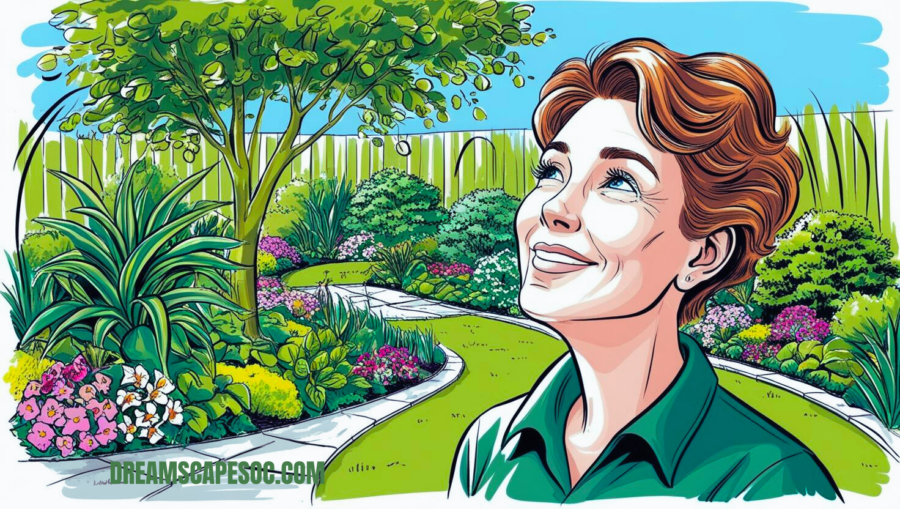What Makes Organic Soil Special?
Organic soil differs from conventional soil because it’s free of synthetic chemicals and rich in organic matter like decomposed plants and animal materials. This kind of soil is full of life, with bacteria, fungi, and earthworms all working together to create a balanced, nutrient-rich environment for your plants. Some key components make organic soil effective:
Organic matter, composed of decomposed plants and animals, boosts soil health by providing essential nutrients like nitrogen, phosphorus, and potassium. Helpful bacteria and fungi break down this matter, releasing nutrients for plants to absorb. Plus, organic soil keeps a steady pH between 6.0 and 7.0, a range in which most plants thrive.
Using organic soil, you’re helping create a natural environment where plants can thrive without chemicals, letting the soil work its magic.
Click here for instant access to Landscaping Design Ideas.
Building the Foundation: Elements of Quality Organic Soil
- The loamy structure of good organic soil is characterized by a balance of clay, silt, and sand. Loam retains moisture efficiently, drains rapidly, and promotes vigorous root growth. Your soil may hold too much water if it is too clay-like, or it may not hold water properly if it is too sandy. For most gardens, a balanced loam works best because it maintains a robust root system and makes nutrients available to plants.
- Nutrient Content: Plants need essential nutrients to grow, and organic soil is naturally packed with them. The three key nutrients for plants are nitrogen (N), phosphorus (P), and potassium (K)—often referred to as NPK. These nutrients are essential for plant health. Secondary nutrients including calcium, magnesium, and sulfur are also present in organic soil and support the robustness and resilience of plants. These nutrients are considerably safer for your garden ecology because they are derived from compost, decomposing leaves, and manure rather than synthetic fertilizers.
- Microbial Activity: A thriving colony of microorganisms, including fungi, bacteria, and earthworms, makes up healthy organic soil. These tiny assistants distribute nutrients, break down organic debris, and build a soil framework that permits root respiration. Dead matter is converted into plant food via the organic soil life cycle, giving plants all they require to develop robustly and healthily.
- pH Balance: Most plants thrive in a bit acidic soil to neutral, ideally with a pH between 6.0 and 7.0. Organic soil often maintains this balance naturally, but it’s still a good idea to check the pH if you’re growing plants with specific needs. You can check your soil’s pH right at home. If you need to make adjustments, it’s easy to find organic options like lime to raise the pH or sulfur to lower it.
Transform Your Outdoor Space Today – Download Your Free Landscaping and Gardening Checklist
How to Choose the Best Organic Soil for Your Yard
Picking the right organic soil for your garden really comes down to what you’re planting. There are various organic soil mixes, each designed to support different types of plants. Compost-enriched soil, which is nutrient-rich and well-balanced, works well for vegetable gardens, flowers, and herbs. Peat-based soil is light and airy, making it great for potted plants. Manure-based soil is packed with nitrogen and is perfect for vegetables and flowering plants that are heavy feeders.
When shopping for organic soil, consider what type of plants you’ll be growing. Also, if possible, buy local to reduce the environmental impact of transport and ensure you’re getting soil that’s well-suited to your area.
DIY Organic Soil: Making Your Own Nutrient-Rich Blend
Creating your organic soil blend is a rewarding, affordable option that lets you control exactly what’s in your soil. An essential DIY mix uses compost, topsoil, and sand. Compost adds nutrients, topsoil forms the base, and sand improves drainage. You can tweak this blend based on your garden’s needs until it’s right. You can improve your mix by adding things like coconut coir to retain moisture or leaf mold, which is made of decayed leaves. Aged manure is perfect for vegetable plants since it also adds extra nitrogen.
Try different ratios to see what works best for your plants, and make sure your homemade soil is meeting your garden’s needs by checking it from time to time.
Preserving the Health of Organic Soil
Your garden will remain bright and fruitful if you maintain the health of your soil on a regular basis. To maintain the health of organic soil, follow these tips:
- Mulching: Helps control weeds, moderate soil temperature, and retain moisture. Mulch is an easy approach to maintain the health and productivity of your land.
- Cover and Rotate Crops: Rotating your crops prevents soil depletion, especially if you grow similar plants in the same spot every year. Planting cover crops like clover or rye also helps replenish nutrients and keeps the soil surface protected. Before you plant again, the cover crop returns to the soil to boost fertility.
- Soil Testing: By regularly testing the soil, you can monitor the pH and nutrient levels and make sure plants are getting the nutrients they need. Soil testing kits are available at a lot of garden centers and online. You can maintain the balance of your soil and the happiness of your plants by doing a quick test and making the necessary adjustments.
Troubleshooting Common Organic Soil Issues
Organic soil can face challenges, but most issues are easy to fix if you know what to look for.
- Nutrient Deficiencies: Signs of nutrient deficiencies can vary by plant. For example, yellowing leaves often mean a lack of nitrogen, while purpling leaves may signal a phosphorus shortage. Adding organic fertilizers like blood meal for nitrogen or bone meal for phosphorus can help get your soil back on track.
- Soil Compaction: Compacted soil can prevent roots from spreading and block air and water from reaching plants. Loosen compacted soil by adding organic matter like compost or leaf mold, which breaks up heavy soils and improves drainage. Avoid stepping on garden beds to reduce compaction and keep your soil loose.
- Poor Drainage: If your soil holds excess water, it will give your plants root rot and other issues. To fix drainage issues, just add some sand or perlite to help the water flow better. Raised beds also encourage better drainage, especially in areas with heavy, clay-like soil
| Nutrient Source | What It Adds | Best For |
| Compost | All-around nutrients (N, P, K) | General soil enrichment |
| Bone Meal | High in phosphorus | Root development and flowering |
| Blood Meal | Boosts nitrogen | Leafy greens and fast growth |
| Worm Castings | Nutrients plus beneficial microbes | Improved plant immunity |
| Fish Emulsion | Balanced nutrients with quick-release | Vegetable gardens and young plants |
| Rock Phosphate | Steady source of phosphorus | Flowering and fruiting plants |
| Kelp Meal | Trace minerals and growth hormones | Overall plant health and resilience |
| Aged Manure | Rich in nitrogen (varies by type) | Heavy-feeding plants like vegetables |
Key Takeaway: Organic garden soil is more than just dirt—it’s an ecosystem that supports plants, microbes, and insects, helping your garden thrive sustainably and naturally.
In conclusion
A good garden is built on a foundation of healthy organic soil. You may create a solid foundation for robust, colorful plants by emphasizing organic matter, helpful microorganisms, and appropriate nutrient balance. In addition to being beneficial for your yard, An eco-friendly and sustainable alternative is organic gardening. If you take the time to develop your soil, you will have a garden that grows beautifully and naturally throughout the year.
FAQs
Which low-cost methods are available for creating organic soil at home?
Compost, dirt, and sand can be combined to create homemade organic soil; additional nutrients can be added with manure or leaf mold.
How frequently should I test the soil in my garden?
As a general rule, testing should be done once a year, preferably prior to planting. This guarantees that pH and nutrition levels are maintained.
How can I enhance the texture of my soil?
Adding compost, leaf mold, or coconut coir can improve soil texture by aiding water retention and aeration.
Can I use kitchen scraps directly in my soil as organic matter?
It’s best to compost kitchen scraps first to avoid attracting pests and ensure they break down properly.
How do I adjust my soil pH naturally?
To raise pH, add lime; to lower it, add sulfur. Always test your soil first, so you know how much to use.


